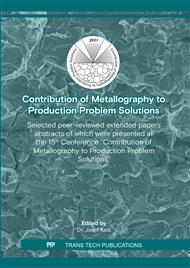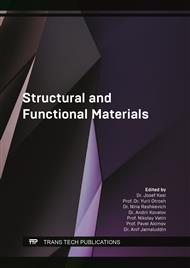p.31
p.37
p.43
p.49
p.57
p.63
p.70
p.77
p.82
Surface Modification of Alumina Particles to Enhance Bonding Properties with Rubber and Resin in Grinding Tools
Abstract:
The mechanical properties of grinding-tools relies highly on adhesion between the abrasive particles and the bonding phase, generally composed of organic rubber or resin materials. The surface modification of abrasive particles represents an industrial alternative to improve the connection with the bonding phase material. However, increasing the roughness of abrasive particles is a challenging process because of their high chemical stability. In the present study, three different approaches are investigated to modify the surface of industrially used alumina abrasive particles. Chemical erosion under harsh acidic and alkaline conditions, and hydrothermal deposition of aluminium-based coatings were used for the surface modification of the abrasive particles. The chemical stability of alumina particles was demonstrated by the chemical etching while the succesufull surface deposition of AlOOH crystals modified the apparent roughness of the processed powder particles. Morphological changes after each treatment were studied by scanning electron microscopy and the phase composition was confirmed by X-ray diffraction.
Info:
Periodical:
Pages:
57-62
Citation:
Online since:
July 2022
Price:
Сopyright:
© 2022 Trans Tech Publications Ltd. All Rights Reserved
Share:
Citation:



